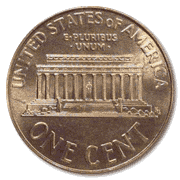Once you get the idea that flipping a coin n times produces 2n possible results, it’s just a short step to Cantor’s description of exactly how big is the set of real numbers.
Let’s go back to those real numbers between zero and one, but instead of describing them in base ten, let’s describe them in base two – binary – the same way that numbers are stored in a computer. So instead of a 1/10 place, a 1/100 place, a 1/1000 place, and so on, there’s a 1/2 place, a 1/4 place, a 1/8 place, etc. And instead of digits 0 through 9, we just use digits 0 and 1.
Here are some examples of real numbers in base two:
0.100100111001…
0.001010011011…
0.101110101110…
You can use binary digits to express any real number. For example, 1/4 in binary is 0.01, and 1/3 is 0.010101… (repeated forever).
Cantor’s clever idea was to look at each 1 or 0 digit as the result of a coin flip, where 1 means heads and 0 means tails. When you look at it this way, you see that each real number is just one possible outcome of flipping a coin over and over again, and writing down the result after each flip.
Suddenly, just by looking at it this way, it all becomes obvious. Every time you add one digit, you double the possible number of outcomes. If N represents “how many counting numbers there are” (a kind of infinity), and R represents “how many real numbers there are” (another kind of infinity), then it’s easy to show, from the coin flip argument, that R = 2N.
And that’s just what Cantor showed: That “how many real numbers there are” (ie: any quantity that could ever appear on a number line) is 2 to the power of “how many counting numbers there are” (ie: 1,2,3,…,∞).
In other words, there are a hell of a lot more real numbers than there are counting numbers.
Cantor went on to show that there are even bigger kinds of infinity. In fact, infinities form a kind of nested chinese boxes: You can look at 2R to get an even bigger infinity. Then you can raise 2 to the power of that infinity to get yet another one bigger than that, and so on and so on.
This sequence of infinities is usually written using the hebrew letter ![]() , with a little subscript to indicate which infinity you’re talking about. For example the smallest infinity, which is “how many counting numbers there are”, is written
, with a little subscript to indicate which infinity you’re talking about. For example the smallest infinity, which is “how many counting numbers there are”, is written ![]() 0, and the next smallest infinity, which is “how many real numbers there are”, is written
0, and the next smallest infinity, which is “how many real numbers there are”, is written ![]() 1.
1.
One question that nags at me, is whether that’s really all you can do to get bigger infinities. I mean, we’re just counting up infinities here one by one: ![]() 0,
0, ![]() 1,
1, ![]() 2,…
2,…
Why restrict ourselves to those boring old counting numbers that Euclid was throwing around way back in 300 BC? One thing that Cantor never talked about, and that I can’t seem to find discussed anywhere else, is whether you can go up faster than just counting the infinities one by one. For example, why can’t we talk about ![]()
![]() 0 or
0 or ![]()
![]() 3, or even
3, or even ![]()
![]()
![]()
![]() 3?
3?
Or maybe I’m just being greedy. 🙂



